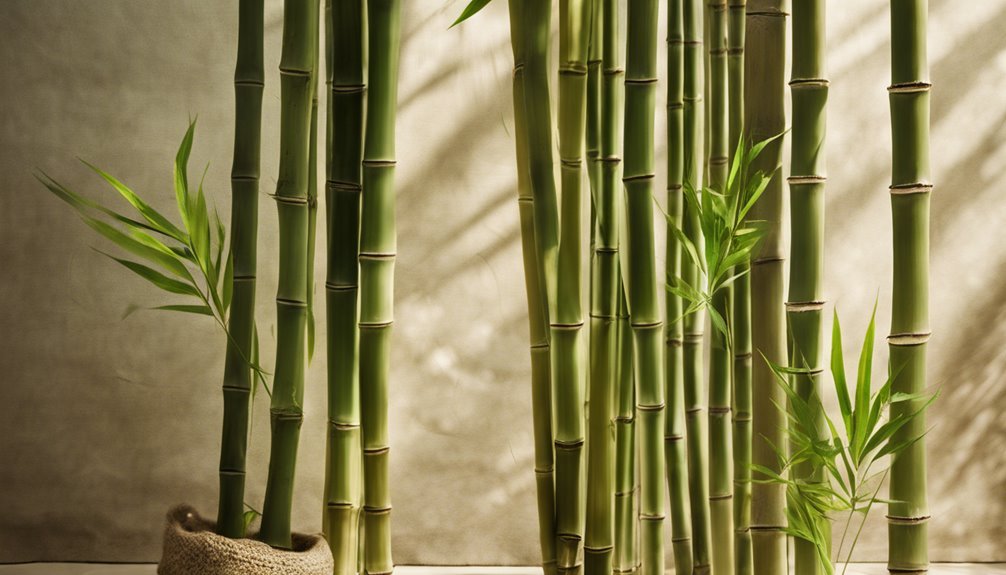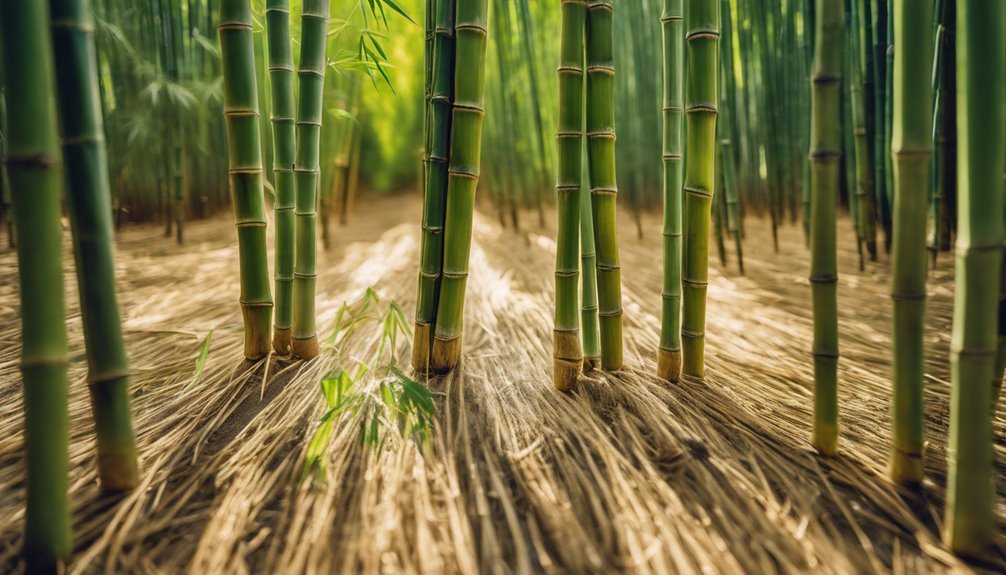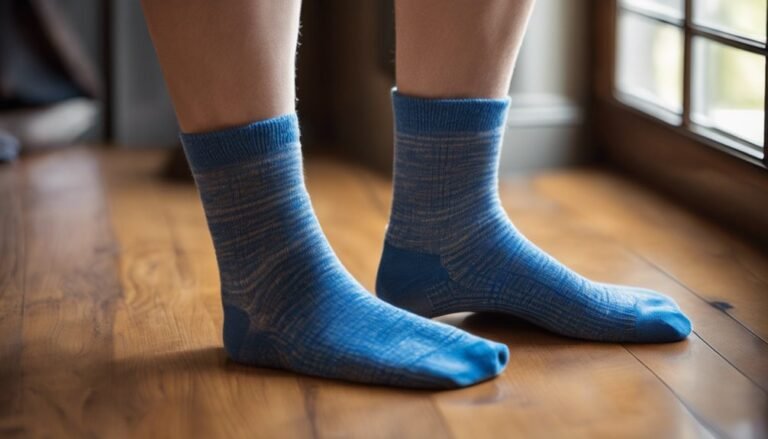Bamboo vs. Hemp Socks: Which Is More Eco-Friendly?
When comparing bamboo and hemp socks for eco-friendliness, both materials shine in different ways. Bamboo is a fast-growing renewable resource that biodegrades quickly, but its production may involve chemical processing. Hemp, on the other hand, thrives with minimal water and pesticides, enhancing soil health and durability. While bamboo offers moisture control, hemp is known for its long-lasting strength. To choose the best for your values, consider their cultivation and production impacts, as there's more to explore!
Understanding Bamboo as a Sustainable Material

As you explore sustainable materials, you might be surprised by how bamboo stands out. Known for its rapid growth, bamboo can reach maturity in just three to five years, making it an incredibly renewable resource. This unique trait allows for sustainable harvesting without the long wait associated with traditional timber. When harvested correctly, bamboo regenerates quickly, ensuring minimal environmental impact. Its natural resilience means it can thrive in diverse climates, reducing the need for pesticides and fertilizers, which contribute to soil health. Bamboo's versatility extends to various products, including clothing and textiles, providing eco-friendly options for conscious consumers. By choosing bamboo, you're not just opting for comfort; you're embracing a sustainable lifestyle that respects the planet's resources.
The Benefits of Hemp in Eco-Friendly Fashion
Bamboo isn't the only sustainable material making waves in the eco-friendly fashion world; hemp is another powerhouse worth exploring. When you look at hemp advantages, you'll find it's a highly durable, breathable, and biodegradable fabric. Unlike conventional materials, hemp requires minimal water and no pesticides, making it a champion of sustainable fashion. Its natural anti-bacterial properties keep your feet fresh while wearing hemp socks, and the fibers soften with each wash, providing long-lasting comfort. Hemp cultivation also enriches the soil, promoting biodiversity, which aligns perfectly with eco-conscious values. By choosing hemp-based products, you're not just opting for style; you're embracing a lifestyle rooted in sustainability and freedom, contributing to a healthier planet for future generations.
Cultivation Practices: Bamboo vs. Hemp
While both bamboo and hemp are celebrated for their sustainability, their cultivation practices reveal distinct approaches that impact the environment. Bamboo often thrives in monoculture settings, requiring minimal organic farming methods but can lead to soil depletion. In contrast, hemp is usually grown in diverse crop rotations, enhancing soil health and supporting pest management through natural ecosystems.
Here are some key points to reflect on:
- Bamboo grows rapidly, maturing in just a few months.
- Hemp can be cultivated without harmful pesticides, promoting biodiversity.
- Organic farming practices in hemp cultivation improve soil fertility.
- Bamboo cultivation may lead to deforestation if not sourced responsibly.
- Hemp's versatility allows it to be used in various products, reducing waste.
Choosing between them ultimately depends on your eco-ethical priorities.
Environmental Impact of Production Processes

When considering the environmental impact of production processes, you'll find that bamboo and hemp socks have different footprints due to their unique manufacturing methods. Bamboo production often involves chemical processing, which can increase its carbon footprint despite the plant's rapid growth and renewable nature. In contrast, hemp socks typically originate from sustainable agriculture practices, utilizing minimal pesticides and fertilizers, leading to a lower overall environmental impact. Hemp's cultivation improves soil health and captures carbon, making it a strong contender in eco-friendliness. While bamboo can be sustainable, its processing methods can undermine those benefits. Ultimately, understanding these differences allows you to make a more informed choice for your eco-conscious lifestyle.
Durability and Performance of Bamboo and Hemp Socks
Socks made from bamboo and hemp each offer unique attributes regarding durability and performance. Bamboo socks are known for their softness and ability to withstand wear and tear, while hemp socks boast remarkable durability and strength. When considering moisture management, bamboo excels, keeping your feet dry and comfortable.
- Bamboo is naturally antibacterial, reducing odor.
- Hemp fibers are robust, making them long-lasting.
- Both materials are breathable, enhancing comfort.
- Bamboo offers a silky feel, perfect for sensitive skin.
- Hemp absorbs moisture effectively, preventing dampness.
Choosing between bamboo and hemp comes down to your specific needs. If you crave softness and moisture control, bamboo may be your best bet. However, if durability and a rugged feel are what you're after, hemp could be your ideal choice.
Biodegradability and End-of-Life Considerations
As you consider the environmental impact of your footwear choices, the biodegradability of bamboo and hemp socks becomes a significant factor. Both materials offer unique end-of-life benefits, making them appealing for eco-conscious consumers.
| Material | Biodegradation Rates |
|---|---|
| Bamboo | 1-2 years |
| Hemp | 3-5 years |
Bamboo socks break down faster, typically within a year or two, making them excellent for composting options. In contrast, hemp socks take a bit longer but are still biodegradable, contributing to a lower impact on landfills. By choosing either option, you're supporting sustainable practices, but understanding these nuances can help you align better with your environmental values.
Making an Informed Choice: Which Sock Is Right for You?

When choosing between bamboo and hemp socks, it's essential to take into account their environmental impacts, comfort, and durability. Each material offers unique benefits that can influence your decision based on your lifestyle and values. By evaluating these factors, you can find the perfect socks that meet both your needs and your eco-conscious mindset.
Environmental Impact Comparison
While the choice between bamboo and hemp socks may seem trivial, their environmental impacts reveal a deeper narrative about sustainability and consumer responsibility. Both materials serve as sustainable alternatives, but they differ in their ecological footprints. Bamboo grows rapidly, requires less water, and can be cultivated without pesticides, making it environmentally friendly. Conversely, hemp boasts a lower ecological footprint overall, as it enriches the soil and requires minimal resources.
Consider these points when deciding:
- Bamboo's fast growth cycle
- Hemp's ability to improve soil quality
- Pesticide-free production of both
- Water conservation in bamboo farming
- Durability and longevity of hemp socks
Ultimately, understanding these factors helps you make informed choices aligned with your values.
Comfort and Breathability Factors
Choosing the right sock goes beyond just sustainability; comfort and breathability play essential roles in your overall experience. Bamboo socks are renowned for their moisture management, effectively wicking away sweat to keep your feet dry and comfortable. This feature is particularly beneficial during warm weather, as bamboo also excels in temperature regulation, helping to maintain a cool feel.
On the other hand, hemp socks offer a slightly coarser texture but provide excellent breathability. They're known for their durability, which means they can handle your active lifestyle while still allowing for airflow. Ultimately, if you prioritize soft comfort and moisture control, bamboo might be your go-to. However, if you're looking for breathable, natural fibers that stand the test of time, hemp could be your best choice.
Durability and Longevity Analysis
After contemplating comfort and breathability, durability plays a pivotal role in sock selection. When you're choosing between bamboo and hemp socks, you'll want to focus on their wear resistance and fabric strength. Bamboo socks are often softer but may wear out faster, while hemp socks, known for their toughness, can withstand more rigorous use.
Here are some factors to ponder:
- Longevity: How long will they last with regular wear?
- Maintenance: Are they easy to clean and care for?
- Resistance: Can they hold up against moisture and odor?
- Breathability: Do they stay cool during intense activities?
- Eco-Impact: How sustainable are the materials used?
Making a choice means balancing comfort with durability for your lifestyle.
Frequently Asked Questions
Are Bamboo Socks Softer Than Hemp Socks?
You'll find bamboo socks often feel softer against your skin, like a gentle caress. With regard to breathability comparison and durability analysis, bamboo tends to excel, offering comfort without sacrificing longevity.
Can Bamboo and Hemp Socks Be Recycled?
Yes, bamboo and hemp socks can be recycled, though the recycling processes may vary. By engaging in sustainability practices, you contribute to a circular economy, promoting environmental freedom and reducing waste in the long run.
How Do Bamboo and Hemp Socks Compare in Comfort?
Imagine a dance between two fabrics; bamboo's breathability sings a cool melody, while hemp's sturdy rhythm offers robust moisture management. You'll find both provide comfort, but bamboo often feels lighter and softer against your skin.
What Are the Costs of Bamboo vs. Hemp Socks?
When considering costs, you'll find a price comparison shows bamboo socks often cost less due to cheaper material sourcing. Hemp socks tend to be pricier, reflecting the more sustainable, labor-intensive cultivation process involved.
Are There Any Allergies Associated With Bamboo or Hemp?
You might wonder about allergies. Bamboo allergies are rare but can occur, often linked to chemicals used in processing. Hemp allergies are also uncommon, though some may react to pollen. Always check for sensitivities before trying new fabrics.






